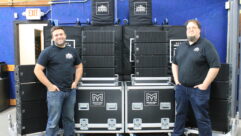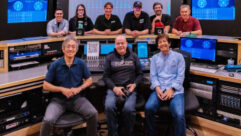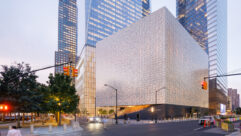
Audio for the Arts
Feb 1, 2008 12:00 PM,
By Charles Conte
The theaters of the Gallo Center for the Arts provide optimal sound for live performances.
Sidebar
A Closer Look at the Mary Stuart Rogers Theater

The acoustic design and technology of the Mary Stuart
Rogers Theater in the Gallo Center for the Arts accommodates both amplified and unamplified performances. Photos: Bill Wood
A decade ago, the city of Modesto, Calif. dreamed of building an arts center. Existing theaters — high school auditoriums, the Modesto Junior College auditorium, and the State Theater — were inadequate to accommodate the variety of performance events the community wanted to host.
In 1997, Marie Gallo, who was married to the son of winery co-founder Julio Gallo, convinced her family to donate a $10-million endowment toward a state-of-the-art venue. While the city of Modesto declined to participate in direct funding for the project, Stanislaus County (population 500,000) agreed to contribute $15 million in land and money. The county became the owner of the new entertainment facility.
The rest of the accumulated funds came from private donors that have local presence: $5 million from the Mary Stuart Rogers Foundation; $3 million from the Foster family; and several donors contributed up to more than $500,000, including the George Lucas family. More than 3,400 individuals in the area also contributed funds to the cause. At the same time, the project underwent a few setbacks and a number of budget-based redesigns — including a deferred art gallery and garden courtyard.
In the end, with a $55-million final budget, Modesto was able to realize its goal for the Gallo Center for the Arts — especially with regard to architecture and acoustic quality of its two theater spaces: the 1,250-seat Mary Stuart Rogers Theater and the 444-seat Foster Family Theater. Arts Center Chairman Fred Silva says the board decided early on not to skimp on quality but to try to build a world-class facility, recruiting top design professionals to make that happen.
Acoustic consultant and AV designer JaffeHolden (Norwalk, Conn., and Santa Monica, Calif.) — working with Executive Architect Steve Gaffney (Nestor+Gaffney Architecture, Santa Ana, Calif.) — assisted with the design of the two theatrical spaces from the beginning to ensure that the theaters presented optimal sound for both amplified and unamplified performances and were insulated from outside noise.

For front-of-house monitoring, the Mary Stuart Rogers Theater is equipped with a Yamaha PM5D-RH digital console. A second Yamaha PM5D-RH handles monitor duties for the Rogers theater, but that console can also be moved to the Foster theater where it can cover FOH while that theater’s Yahama M7CL console is used for monitor mix.
ACOUSTICS FOR TWO SPACES
JaffeHolden provided room-acoustics consultation on the design and construction for the Mary Stuart Rogers Theater and the Foster Family Theater. Both halls host a wide variety of programs — both acoustic and amplified. The Rogers Theater is home to the Modesto Symphony Orchestra, which performs opera and ballet performances without amplification. However, Broadway shows and pop concerts held there are amplified events. The Foster Theater hosts numerous family theater productions and other dramatic events that emphasize unamplified vocal clarity, but some performances do require amplified sound.
For symphonic music and opera, the general acoustic requirement of a hall is a degree of reverberation that allows performers to balance an articulated style of playing with a fullness and richness of tone. For the audience, this balance results in a sense of immediacy and involvement in the music. For amplified programs, the acoustics need to be fairly dry with a relatively low reverberation time. A dry acoustic environment supports amplified voice projection — providing a high level of speech intelligibility — and amplified music.
JaffeHolden’s solution to this challenge was first to provide sufficient volume in the hall to develop the degree of reverberation needed for classical music — approximately 2 seconds at mid-frequency, occupied. “The means to adjust the reverberant character of the hall was provided in the form of retractable, sound-absorptive draperies,” says JaffeHolden acoustician Mark Reber. “For most classical music programs, the drapes will be fully retracted, allowing reverberation to develop. For theater and amplified programs, the drapes will be deployed in varying amounts, giving a range of flexibility down to a dry condition suitable for speech alone — between 1.4 to 1.5 seconds at mid-frequency.”
This ability to tune the room acoustics gives a great range of control and choice to theater directors, conductors, and performers. In late August, JaffeHolden construction project manager Robin Glosemeyer Petrone and principal Christopher Jaffe spent a day in the Rogers Theater recording sound levels in order to determine different configurations for draperies and acoustic panels that would be suitable for many types of performances.
Additionally, a demountable concert enclosure can be used on stage to create the proper room acoustics essential for natural music performances. “The concert enclosure provides sound reflections that enhance on-stage hearing for the musicians,” Reber says, “as well as project a balanced and properly timed series of early reflections to the audience.”
The acoustic requirements for the Foster Family Theater are as varied as those for the larger Rogers Theater, but there’s a much heavier emphasis on dramatic performance. “Proper projection and intelligibility of unamplified voices were the key acoustical design goals here,” Reber says. “The design approach was again to provide sufficient volume in the hall to develop the degree of reverberation needed for classical music with variable drapery deployed to adjust the reverberant character of the hall down to levels appropriate for speech and amplified performances.”
Audio for the Arts
Feb 1, 2008 12:00 PM,
By Charles Conte
The theaters of the Gallo Center for the Arts provide optimal sound for live performances.
Sidebar
A Closer Look at the Mary Stuart Rogers Theater

Because the 444-seat Foster Family Theater would play host to both unamplified and amplified performances, the theater was outfitted with acoustical drapery panels that provide the appropriate amount of reverberation.
AV SYSTEMS DESIGN
Media Systems Design Group was part of the design process for the Gallo Center theaters almost from the inception of the project, delivering the original spec for both performance spaces in September 2003. Audio system essentials included center-cluster front-of-house systems and analog FOH consoles for both the large and smaller performance venues — although the infrastructure for the addition of digital consoles was specified at the time, says Timothy Hart, project lead.
By June 2006, client-level administrative changes brought about revisions in the basic specifications: The center-cluster design for both venues became left-right vertical arrays, and the analog consoles were replaced with digital consoles that had monitor-mix capabilities.
The project was put out to bid in August 2007, and the audio system design bid was awarded to Professional Communication Design, Santa Rosa, Calif., in April 2007. At that time, Hart says other revisions to the spec were made — specifically, for both venues to include more flexibility in the wiring, such as mic patching from the stage to the control rooms.
The FOH systems for both the Rogers and the Foster theaters are based around Yamaha digital consoles. A PM5D-RH is housed in the Rogers theater and an M7CL in the Foster theater. (Control rooms in both theater venues are supplemented by mix positions on the floor.) A second Yamaha PM5D-RH handles monitor duties for the Rogers theater, but it can be moved to the Foster theater, where the Yamaha M7CL FOH console can be used for monitor mix as well. “The staff and anyone who has mixed on them finds these consoles easy to use,” says Scott McKay, the Gallo Center’s director of production. “My experienced staff is always finding something new they can do with these consoles.”
The loudspeaker systems include eight JBL Vertec 4888 mid-size line arrays per side that are supported by four subs in the Rogers theater. In the Foster theater, six VRX932LA line arrays per side are supported by four VRX-series subs that are not part of the flown system. Renkus-Heinz center clusters — six loudspeakers in the Rogers theater and three in the Foster theater — complete the flown systems. “Stage lip fills [five Tannoys in the Rogers and three in the Foster] were added to the system with the final budget alteration,” Hart says. “These were a welcome addition.”
Public and professional reception for the center — particularly for the Rogers theater — has been uniformly enthusiastic. Architect Steve Gaffney was given a design excellence award by the local chapter of the American Institute of Architects. At the gala opening last September, Christopher Jaffe called the center a magnificent building, adding that it might be one of the most economical arts centers in the country, as well.
During the gala week of performances, Tony Bennett, Patti LuPone, and Rosanne Cash all praised the acoustics and the sound system of the Rogers theater, with Bennett and LuPone each singing a song without benefit of the sound system to demonstrate the hall’s natural acoustics. At the premiere of the Modesto Symphony Orchestra last October, led by longtime Cincinnati Pops Orchestra Conductor Eric Kunzel, the maestro told the audience that during rehearsal he listened to the orchestra from various places throughout the hall. Familiar with many musical venues built in this country during the last 25 years, Kunzel says that after listening to the orchestra in the Gallo Center, he was convinced: “Modesto has the best new hall in America.”

The 1,250-seat Mary Stuart Rogers Theater in the Gallo Center for the Arts has a traditional shoebox shape that keeps with the theater’s primary use as a classical-music venue.
A Closer Look at the Mary Stuart Rogers Theater
The Mary Stuart Rogers Theater seats approximately 1,250 people, with as many as 945 patrons at the orchestra and parterre levels and 305 patrons in the balcony.
The hall is a traditional shoebox shape, which keeps with its primary use as a classical-music venue. With a maximum width of 97ft. tapering to approximately 72ft. between the side walls just forward of the proscenium, the theater’s dimensions are favorable for directing early sound reflections toward the center portions of the orchestra seating areas. The farthest seat from the proscenium is almost 100ft. away in the balcony, yet there’s still a good degree of intimacy and overall loudness of sound.
A demountable orchestral shell serves the dual purpose of enhancing on-stage hearing for musicians and projecting early reflections out into the audience. Forestage reflectors suspended in the audience chamber, just forward of the proscenium, extend over the orchestra pit and into the hall, directing early reflections from within the orchestra shell to the front positions of the seating area. These reflectors enhance on-stage hearing for those who are situated on the pit forward of the proscenium, improve ensemble hearing in the orchestra pit, and provide reinforcement of low-power string instruments.
These forestage reflectors also help frame the 27ft.-tall proscenium. Sliding tormenters adjust the proscenium frame width from between 60ft. to 40ft. The stage is 45ft. deep by 102’6″ wide. Beyond that, a scene dock provides storage space for the orchestra shell towers and accommodates rear projection.
The orchestra pit, a portion of which extends under the stage to ensure balance between the orchestral sections, is sized to accommodate approximately 40 musicians. The rear wall is articulated to promote sound diffusion, and it has removable draperies for variable sound absorption.
A tension grid mounted above the audience provides theatrical lighting positions. The grid is arrayed along concentric arcs that mimic the seating rows below and form a virtual ceiling plane or “chandelier” with integrated house lighting fixtures. Followspot positions are located above the balcony. Balcony-edge and sidewall locations fill out the theatrical lighting positions. — C.C.









